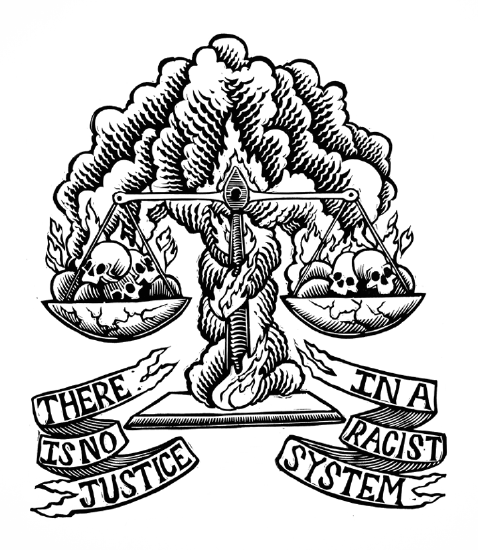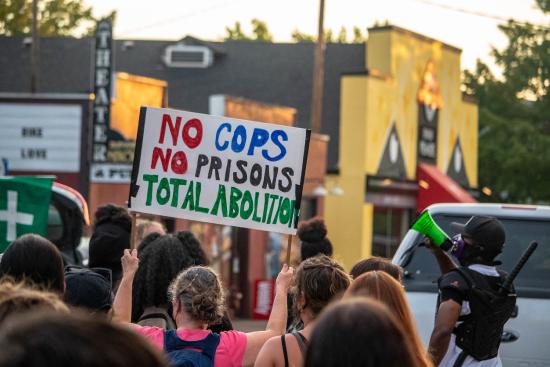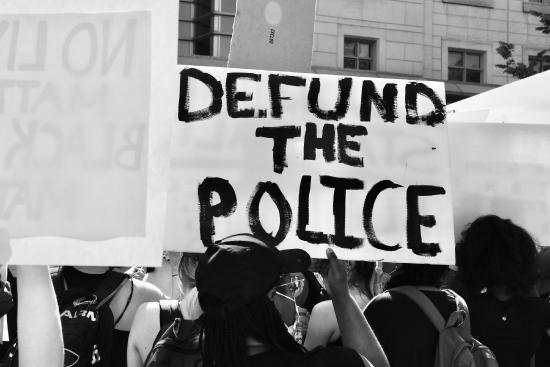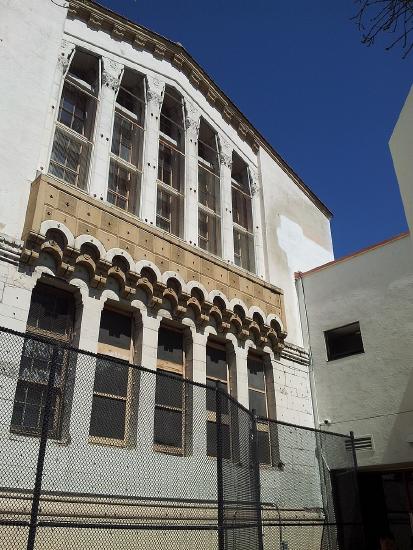10.7: Alternative Solutions
- Last updated
- Save as PDF
- Page ID
- 143350
- Ulysses Acevedo & Kay Fischer
Building a Youth Support Complex

When thinking of alternative solutions to modern day incarceration, we must examine and learn from the culture of policing before colonization of the Americas and how policing has been used to further the efforts of colonization. For example, the modern day Tribal Police found on many Native American reservations are the product of various attempts to police Native Americans who were relegated to segregated and isolated communities.
American Indians were not allowed to participate in policing reservations until the 1860s (Wakeling et al., p.41). Although at that point most of those who were policing reservations were Native American (local tribal members and from other reservations), some continued to be non-native. However, because they were a part of the policing institution Native Americans were seen as representatives of the U.S. government and in many cases not trusted (p. 41). “Their duties included determining whether a fellow tribesman was working enough to merit his sugar, coffee, and tobacco rations” (p.41). This relationship between tribal members and Tribal Police caused much animosity which the federal government was more than happy to take advantage of. Moreover, the federal government believed that utilizing Native Americans as Tribal Police was more viable than utilizing white officers due to the shared experiences that native officers had with the local population.
In his book, Punished: Policing the Lives of Black and Latino Boys, Dr. Victor Rios, who teaches Sociology at UC Santa Barbara and has a PhD in Ethnic Studies, tells us how young Black and Latinx boys in Oakland’s Fruitvale district have not been abandoned by the state but instead are hypercriminalized by what he theorizes as the Youth Control Complex. Rios defines the Youth Control Complex as a system of criminalization molded by the synchronized, systematic punishment meted out by socializing and social control institutions (Rios, 2011, p. 21). Rios emphasizes that there are many approaches to interrupting the hypercriminalization of young Black and Latinx boys and the school-to-prison pipeline and the following are some of his solutions toward dismantling the Youth Control Complex.
This section will focus on the solutions Rios proposes in the closing chapter, especially those found in: “Building a Youth Support Complex, Facilitating Dignity and Freedom for All Young People, and One Youngster at a Time” (Rios, 2011, p. 161). When creating a Youth Support Complex Rios states that youth will need many mentors along the way with academic, cultural, and affirmative action programs (p. 162). Furthermore, when poor, young, Black and Latinx boys make mistakes they should be given the opportunity to learn and grow from their mistakes in order to allow transformation (p. 162). Rios also emphasizes that their resistance should be redirected toward learning to navigate mainstream institutions to become more productive citizens. By remaining free from prison, the boys in this study demonstrated that they were resisting the system: “freedom is work.” Rios adds that “the social movements of the new millennium among the most marginalized classes will be centered on dismantling punitive social control” (p. 163). These sections also suggest that when policymakers want to be supportive they will have to take risks when proposing (and implementing) new policies to dismantle punitive social control (p. 164).
Furthermore, Rios recommends that schools and criminal justice institutions “respect and embrace the work that young people do for dignity and freedom” (2011, p. 164). He also advocates having participation from young people when creating programs that can support them and in turn empower them simultaneously (p. 165). Rios writes, “the key is to provide all marginalized youths a stage with good props, good lighting, and a supportive audience” (p. 166). Ultimately Rios urges the reader that “redistributing resources from criminal justice institutions back into nurturing institutions must become a priority” (p. 166).
Abolition Now

In her book, Are Prisons Obsolete? (2003) Angela Y. Davis mentions that prison abolitionists are stereotyped as utopian dreamers and naive. Davis goes on to state that the general free population have a passive role in consenting when new prisons are being built. The logic of the free population is that when more prisons are built, the more the free population feel that their rights are being protected. Ultimately, the Prison Industrial Complex (PIC) has distorted the free population's sense of harm and attributed abolition to “letting people off easy.”
In order to address how prison abolitionists are stereotyped as utopian dreamers we need to critically analyze prisons as a racial or racist project. How is prison abolition a racial project?
For example, the original idea of a stimulus check in 2020 to financially aid the unemployed and financially impacted during the COVID-19 pandemic was an idea of utopian dreamers. This immediately caused uproar from right wing proponents. Questions arose, such as: Who would be worthy of getting a stimulus check? Who would pay for it? Was this a band aid solution that would have major repercussions? It is imperative to highlight how the pushback against the idea of a stimulus check to those facing economic hardships during COVID-19 may have had racial undertones.
When examining the pushback against even the very idea of prison abolition, we need to be fully aware of the racialized undertones. When prison abolition is seen as a goal synonymous with utopia, what does that utopia look like? Whose utopia? What do the racial demographics look like in an abolitionist utopia? As we have covered throughout this chapter, the creation of police and prisons have led the US towards a carceral dystopia.
The first book from Kaepernick Publishing is called Abolition for the People: The Movement for a Future Without Policing & Prisons (2021). Many important authors involved in the abolition movement are included in this work such as: Angela Davis, Kimberlé Crenshaw, Mumia Abu-Jamal, Robin D.G. Kelley, among others. One purpose of this work is to “ensure that the book before you is useful and that it inspires you to take action to build a world without and beyond police and prisons” (Kaepernick, 2021, p.13). The book argues “that the efforts to reform police and prisons have nearly always enhanced their power, reach, and legitimacy” (Preface). Furthermore, Abolition for the People aims to answer the following questions: What is abolition? Is abolition practical? and what does abolition look like in the real world? Abolition is defined by Dylan Rodriguez as “the work of constantly remaking sociality, politics, economy, place and (human) being against the duress that some call dehumanization, others name colonialism, and still others identify as slavery and incarceration” (Kaepernick, 2021, p.15).
In Abolition for the People, Robin D.G. Kelley writes in "Change from the Roots: What Abolition Looks Like, from the Panthers To The People" that the abolitionist movement is not new and that the “Black Panther Party (BPP) was formed in 1966 in Oakland, California, precisely to monitor police violence” (Kaepernick, 2021, p.189). Through their abolitionist work the BPP provided many services to their communities such as the free breakfast program, patrolling the streets, know-your-right workshops, exposing the names of brutal police, and liberation schools for children (Kaepernick, 2021, p.189). Furthermore Kelley defines Abolition as,
Work[ing] to dismantle systems that have caused harm, namely police and prisons, and reallocate funds to social and economic resources, and to develop new systems of community-controlled public safety and restorative justice (Kaepernick, 2021, p.187).
The abolitionist movement is very real such as the Movement for Black Lives, a coalition that is made up of over 150 abolitionist organizations. Abolitionist efforts have intentionally worked to center the experiences of gendered violence as a key abolitionist issue (Kaepernick, 2021, p. 187). For more analysis of gender-based violence, please see the sections in this chapter titled "Colonialism and Violence against Indigenous Women," "The Slave Patrol," "Immigration Enforcement," and "Girls of Color."

Defund the Police
Leading police and prison abolitionist, Mariame Kaba wrote “enough” to police reform and giving police departments hundreds of millions of dollars. In a New York Times Op-Ed, Kaba wrote, “Enough. We can’t reform the police. The only way to diminish police violence is to reduce contact between the public and the police” (2020, para 2). She pointed out that there’s never been a moment in U.S. history when police were not a force of violence against marginalized populations, in order to “protect the status quo” (para 3).
As an abolitionist, Kaba calls for an immediate demand all of us can make, which is to defund the police: “Cut the number of police in half and cut their budget in half. Fewer police officers equals fewer opportunities for them to brutalize and kill people” (para 9). Kaba reminds us that reforms have never proven to reduce violence nor protect vulnerable communities. She points out that, “The philosophy undergirding these reforms is that more rules will mean less violence. But police officers break rules all the time” (para 16) without ever facing serious repercussions.
By defunding the police, Kaba writes that “We are not abandoning our communities to violence” (para 19). Kaba and other abolitionists call to redirect those billions toward health care, housing, education, and jobs so that there would be less need for police in the first place. She calls for trained community care workers to respond to mental-health checks and implement restorative justice models instead of simply throwing people into jail cells. As for the crime of rape, Kaba reminds readers that our current approach isn’t working, and that most rapists never go to court. Two-thirds of people who face sexual violence don’t report it and people who do file a report with the police are typically “dissatisfied with the response” (para 22). Furthermore, it’s police officers themselves who commit sexual assault “alarmingly often” (para 22).
In conclusion, Kaba calls on us to imagine a different approach:
As a society, we have been so indoctrinated with the idea that we solve problems by policing and caging people that many cannot imagine anything other than prisons and the police as solutions to violence and harm. People like me who want to abolish prisons and police, however, have a vision of a different society, built on cooperation instead of individualism, on mutual aid instead of self-preservation. What would the country look like if it had billions of extra dollars to spend on housing, food and education for all? This change in society wouldn’t happen immediately, but the protests show that many people are ready to embrace a different vision of safety and justice (2020, para 23-24).
Alternatives to School Police
There has been some push back recently from the community, youth, and organizers to remove school police. The Oakland School Board, for example, unanimously passed the George Floyd Resolution in June of 2020, after a decade of organizing and advocacy work led by the organizers and youth of the Black Organizing Project (Black Organizing Project). The school board committed to eliminating the Oakland School Police Department and reinvesting the $6 million budget to a safety plan that will work to dismantle the school-to-prison pipeline (Getachew, 2021, para. 1-2). In 2021, Los Angeles Board of Education voted to eliminate a third of the Los Angeles School Police Department’s police force and ban the use of pepper sprays. Other major cities including Seattle and Denver have also recently taken steps to remove funding from school police.
As some districts are pivoting away from an over reliance on ineffective SROs, Vitale calls for non-punitive disciplinary measures in school and to include school staff to be a part of the solution, instead of relying on the criminal justice system. Furthermore, resources that support the whole students can benefit the entire learning community, especially students who shouldn’t have to just focus on testing at the expense of emotional and bodily health (2017, pp. 68 - 69). This includes increased investment in training, counselors, and support staff to provide effective services to students and their families.
For example, the American Federation of Teachers have supported the establishment of “community schools” where they provide wraparound services including medical and mental health care, counseling, tutoring, and social justice programming, as well as adult education for parents. Such services are provided through partnerships with local community organizations (Vitale, 2017, p. 69). In Salt Lake City, the United Way partnered with eleven community schools, with over half of the students coming from low-income families and 25% English learners. This partnership increased academic achievement amongst students and reduced chronic absenteeism. In Baltimore, they have 45 community schools serving a majority poor and student of color population, and such restructuring has improved attendance, reduced suspensions, increased graduation rates and test scores. Some of the schools have uniformed police, but they are unarmed and the community are pressuring to reduce their presence even further (pp. 69 - 70).
Restorative Justice Programs
Restorative justice is considered to be the most established of alternatives to school police and punitive policies against youth. More and more school districts are adopting these methods and turning away from punishment based approaches to student behavior. Based on indigenous practices from across the globe, restorative justice programs address underlying causes and involve students as responsible members of the community.
The program may implement peer juries, problem-solving circles, conflict mediation or community service and requires time to build buy-in from school staff and student trust. Vitale writes that at the center of these programs lies,
... the desire to make schools a welcoming place for young people regardless of the problems they bring to school and to try to work out those problems cooperatively in a way that is in the best interest of the student and the larger school community (2017, p. 70).
One of the core principles involves conflict resolution that requires participants to take on “meaningful responsibility” for their actions and work toward changing them in order to build healthy relationships. It’s about reducing and repairing harm, and restoring positive relationships. In order for this program to be effective, a substantial amount of time and resources must go into training. Vitale also notes that if schools face stress about testing affecting school budgets, it will be difficult to cultivate support and buy-in if teachers will be reluctant about taking time away from instruction. Simply replacing suspensions with forced community service won’t make much of a difference (2017, p. 71).

Fremont High School in Oakland, CA has reported a complete turn-around thanks to a $2.5 million investment into restorative justice programs in their school district. The high school once had the highest student suspension rate in Oakland Unified, but in 2022, the school focused on improving campus climate. Their enrollment has gone up 20%, and the number of students qualifying for college admission has tripled. Tatiana Chaterji, Fremont High’s restorative justice facilitator stated that they’ve “...worked hard on building community, relationship, trust” (Jones, 2022, para 4).
Although the focus of the program started with resolving conflict, now, Fremont High students use restorative justice circles to welcome new students and build bridges across different ethnic groups. They are held in multiple languages including Arabic and Mam, a Mayan language spoken by indigenous migrants from Guatemala. Ebrar Wasel, a junior, expressed that circles in Arabic and English helped her adjust to a new school, especially after fleeing a war in Yemen. She stated, “I used to be scared people would laugh at me…But then in circles, I learned that it was the same for other people, too” (Jones, 2022, para. 14 - 15).
Fremont High students even lead circles at a nearby elementary school, Horace Mann. Aaron Gray of the program at the elementary school shared that “it’s never too early to teach children about restorative practices” and that such skills “will help them feel safer and more comfortable at school, which in turn leads to better academic performance and an overall improved campus climate for everyone” (Jones, 2022, para. 26). He stated that when he first started working at the school, “I was dealing with conflicts all day. But now, there’s been a shift. Kids are resolving their own issues and organizing their own RJ circles….There’s been a huge change in the culture” (para. 27).

